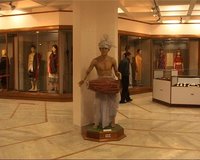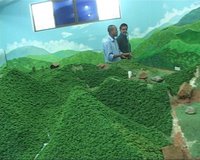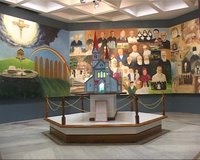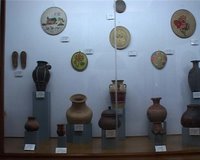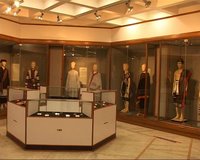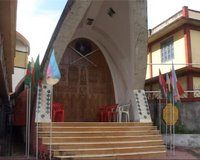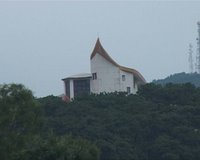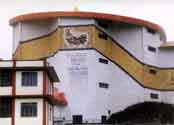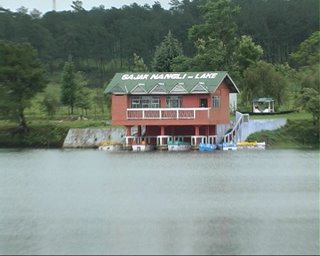Friday, June 23, 2006
A Mini World of the Seven Sisters
Born out of appreciation of the Church and the love of the Salesians for the culture of the North Eastern part of India emerged a mini world of lively accessible and complete world of indigenous people---The Don Bosco Centre of Indigenous Culture (DBCIC).
Situated in Mawlai, though not a much talked about place for a visit, DBCIC stands out to be a unique and wonderful museum which is a treasure place of cultural heritage providing an overview of the whole of North East India under one roof.
In terms of design the DBCIC is startling; built in a hexagonal shape, its seven floors represent the seven states of the region rising in Shillong’s skyline like a flame with a message that if culture are understood well, they can light up and brighten up efforts to build a peaceful, developed and progressive society.
With 56,000 square feet of floor space and 15,154 square feet of display wall space, this mammoth creation holds exotic collections, well maintained galleries with artefacts preserved by Air Dehumidifiers.
The initiative of setting up this masterpiece of culture has its roots in the love of Don Bosco for the peoples’ culture said DBCIC director Father Joseph Puthenpurakal narrating the idea that developed behind the construction of the home for the seven sisters. He said that the foundation stone of the museum was laid in July 1994, and by October 2000 the construction work was completed. He said that the setting up of the galleries and other interior works which had started by them were completed by the middle of 2004.
However, this museum which today paints a picture that it does not lack infrastructure is geared up to add more to its asset like computerization of the museum where one can relate with each item in it to know them better, Father Joseph said.
One has to take two hours time to see all the seventeen galleries displaying artefacts and paintings which some dignitaries in the state as well as visitors from Germany, France and others remark “This is an extraordinary cultural and educational museum. The concept of the building itself is creative and bears testimony the love for the people of North East India by the Don Bosco fathers and their religious associates.”
What to see in the galleries?
Introductory Gallery
With the help of four panels the visitors are given an overview of the whole of North East India. The flora and fauna panel is colourful and attractive.
Prehistory Gallery
The origin of the Universe and Man is shrouded in mystery. There have been efforts to unravel it. Creation and evolution are the two important answers. While the Creationists say that God is the author of the universe and of the origin of man, several evolutionists hold that the universe evolved gradually from simple to complex, from one cell amoeba to man. Today, many scholars are of the opinion that both Creation and Evolution are not contradictory in terms. Evolution requires a moving force, which the creationists would call the “Divine Intervention”. The Prehistory gallery tries to explain the history of Man’s gradual evolution as expounded by Physical Anthropologists.
Land and people’s Gallery
This gallery provides a beautiful overview of the places and peoples of the North East. 32 large size photographs in colour, 26 in black and white and 18 life size fibreglass figures and 60 busts adorn this exciting presentation.
Fishing and Hunting Gathering Gallery
The varieties of baskets used in fishing and the implements used in hunting and the types of containers used during harvesting are indeed astonishing. They give the visitor a glimpse into the creativity and genius of the people’s of the North East.
Agricultural Gallery
Three types of agricultural practices are shown in this Gallery by means of exceedingly beautiful dioramas. The dioramas depict wet cultivation, jhum (or slash and burn or shifting) cultivation, and terrace cultivation. A 255 year old mighty tree in the middle of this Gallery is a graphic demonstration that if slash and burn cultivation disappears from the area; North East could be dotted with huge trees like the one present here.
Traditional Technology Gallery
The peoples of the North East are industrious in their village surroundings. The dioramas showing pottery, wine making, basket making, black smith, gold smith, weaving, wood carving, leather works and cane making provide a quick tour of the North East with appropriate explanations.
Basketry Gallery
A wonderful diorama showcasing four different tribes (Assamese, Karbi, Khasi and Naga) engaged in the same occupation of basket making. The realistic village setup takes the visitor to the remotest corners of the North East. The innermost section displays articles which people use in their homes. A feeling that one has visited many houses in the North East accompanies the visitor as he/ she moves into the next Gallery.
Musical Instruments Gallery
Here the eyes can feast on traditional musical instruments. Once digitized with the help of touch screens, this excellent collection of musical instruments will mesmerize all visitors, especially music lovers.
Religion and Culture Gallery
Twelve large panels guide the visitors through the major religious beliefs and cultures of the world. One cannot rush through it if he/ she prefer to read everything written in this Gallery.
Weapons Gallery
Traditional weapons may not be in use now-a-days. But the Gallery preserves them to enter the past and to experience how people struggled to protect themselves and their dear ones.
Costume and Ornaments Gallery
This is another feast to the eyes. The display of traditional ornaments, shawls and colourful tribal costumes literally take the visitor to the remotest villages of the North East. The Gallery has life size fibreglass figures of men and women of several tribes in their traditional dress: Nishi, Tangsa, Nocte, Apatani, Adi, Mizo, Manipuri, Mao, Angami, Khasi, Pnar, Garo, Karbi, Tiwa, Dimasa and Mising.
Don Bosco and Culture Gallery
DBCIC is dedicated to one of the greatest Educators and Friends of the Young, namely, Don Bosco. The Don Bosco group of Educators are present in all the five continents and in over 140 countries. Through Academic, Technical and Agricultural education as well as other activities, Don Bosco serves the cause of Culture in an eminent degree. The Gallery is a continent wise showcasing of the service to culture around the world rendered by the Don Bosco group of Educators.
Land and Housing Pattern Gallery
Housing Pattern reveals the socio-economic situation of peoples. The Gallery provides insight into this particular aspect and guides the visitor through the whole of North East India, including Sikkim. The mini landscape of the various States of the North East is also a mini tour of the entire region in few minutes. The visitor friendly doors are an added attraction.
Art Gallery
This is another special attraction in DBCIC. The very entrance to it is different from other Galleries. It displays all the seven States and Sikkim by means of their ancient artefacts and paintings. Well-designed and carefully arranged, this Art Gallery is a place wherein the visitor is given a taste of how creative the indigenous peoples are.
Media and Culture Gallery
Culture is something alive. It moves forward. It calls for modern means of presentation. The media and Culture Gallery situated in the topmost floor of DBCIC is a welcome place to relax, to watch a dance, enjoy a cultural celebration and see the life of someone or other who gave his/ her life for the promotion of the cultures of peoples. Echoless and sound proof, quite and free from any disturbance, the Media Gallery is where one can choose a dancer or a festival of one liking. The gallery has a seating capacity for groups of 150 persons at a time. Programmes that will create osmosis of cultures leading to a Culture of Peace, Harmony and Collaboration will be held in this Gallery.
Mission and Culture Gallery
The crown of dances and ornamental figures, the services Mission Work has been rendering in this region – services such as literacy, higher education – academic and technical – medical care, training of leaders, formation of service groups, printing, and publication are some of the very informative panels in this gallery. The Lum Sohpetbneng and the Balpakram stories, the replica of the first Catholic Church of Shillong are some of the attractions of this gallery. Those who choose to read the history of 20 centuries in a few hours will find this gallery particularly helpful.
Photo Gallery
This is a new addition to the cultural centre. It contains original black and white photos of excellent quality. Of the over 450 black and white photos only 120 are exhibited. They were taken from the different parts of Assam by Father Julius Costa, an Italian missionary. The 24 high quality colour photos representing all the states of the North East are from Ahmed Hussain.
Shillong View Point
The Shillong-View-Point right at the top of the Museum building gives a breath taking sight of the city. This is particularly beautiful at night.
“With promotion and development of indigenous cultures as its focus the DBCIC is a fascinating journey of the cultural panorama of the North East - educative and informative - the finest museum in the country which is an amazing potpourri for all to absorb and for the young to value their cultural heritage” remarked one of the visitors.
Situated in Mawlai, though not a much talked about place for a visit, DBCIC stands out to be a unique and wonderful museum which is a treasure place of cultural heritage providing an overview of the whole of North East India under one roof.
In terms of design the DBCIC is startling; built in a hexagonal shape, its seven floors represent the seven states of the region rising in Shillong’s skyline like a flame with a message that if culture are understood well, they can light up and brighten up efforts to build a peaceful, developed and progressive society.
With 56,000 square feet of floor space and 15,154 square feet of display wall space, this mammoth creation holds exotic collections, well maintained galleries with artefacts preserved by Air Dehumidifiers.
The initiative of setting up this masterpiece of culture has its roots in the love of Don Bosco for the peoples’ culture said DBCIC director Father Joseph Puthenpurakal narrating the idea that developed behind the construction of the home for the seven sisters. He said that the foundation stone of the museum was laid in July 1994, and by October 2000 the construction work was completed. He said that the setting up of the galleries and other interior works which had started by them were completed by the middle of 2004.
However, this museum which today paints a picture that it does not lack infrastructure is geared up to add more to its asset like computerization of the museum where one can relate with each item in it to know them better, Father Joseph said.
One has to take two hours time to see all the seventeen galleries displaying artefacts and paintings which some dignitaries in the state as well as visitors from Germany, France and others remark “This is an extraordinary cultural and educational museum. The concept of the building itself is creative and bears testimony the love for the people of North East India by the Don Bosco fathers and their religious associates.”
What to see in the galleries?
Introductory Gallery
With the help of four panels the visitors are given an overview of the whole of North East India. The flora and fauna panel is colourful and attractive.
Prehistory Gallery
The origin of the Universe and Man is shrouded in mystery. There have been efforts to unravel it. Creation and evolution are the two important answers. While the Creationists say that God is the author of the universe and of the origin of man, several evolutionists hold that the universe evolved gradually from simple to complex, from one cell amoeba to man. Today, many scholars are of the opinion that both Creation and Evolution are not contradictory in terms. Evolution requires a moving force, which the creationists would call the “Divine Intervention”. The Prehistory gallery tries to explain the history of Man’s gradual evolution as expounded by Physical Anthropologists.
Land and people’s Gallery
This gallery provides a beautiful overview of the places and peoples of the North East. 32 large size photographs in colour, 26 in black and white and 18 life size fibreglass figures and 60 busts adorn this exciting presentation.
Fishing and Hunting Gathering Gallery
The varieties of baskets used in fishing and the implements used in hunting and the types of containers used during harvesting are indeed astonishing. They give the visitor a glimpse into the creativity and genius of the people’s of the North East.
Agricultural Gallery
Three types of agricultural practices are shown in this Gallery by means of exceedingly beautiful dioramas. The dioramas depict wet cultivation, jhum (or slash and burn or shifting) cultivation, and terrace cultivation. A 255 year old mighty tree in the middle of this Gallery is a graphic demonstration that if slash and burn cultivation disappears from the area; North East could be dotted with huge trees like the one present here.
Traditional Technology Gallery
The peoples of the North East are industrious in their village surroundings. The dioramas showing pottery, wine making, basket making, black smith, gold smith, weaving, wood carving, leather works and cane making provide a quick tour of the North East with appropriate explanations.
Basketry Gallery
A wonderful diorama showcasing four different tribes (Assamese, Karbi, Khasi and Naga) engaged in the same occupation of basket making. The realistic village setup takes the visitor to the remotest corners of the North East. The innermost section displays articles which people use in their homes. A feeling that one has visited many houses in the North East accompanies the visitor as he/ she moves into the next Gallery.
Musical Instruments Gallery
Here the eyes can feast on traditional musical instruments. Once digitized with the help of touch screens, this excellent collection of musical instruments will mesmerize all visitors, especially music lovers.
Religion and Culture Gallery
Twelve large panels guide the visitors through the major religious beliefs and cultures of the world. One cannot rush through it if he/ she prefer to read everything written in this Gallery.
Weapons Gallery
Traditional weapons may not be in use now-a-days. But the Gallery preserves them to enter the past and to experience how people struggled to protect themselves and their dear ones.
Costume and Ornaments Gallery
This is another feast to the eyes. The display of traditional ornaments, shawls and colourful tribal costumes literally take the visitor to the remotest villages of the North East. The Gallery has life size fibreglass figures of men and women of several tribes in their traditional dress: Nishi, Tangsa, Nocte, Apatani, Adi, Mizo, Manipuri, Mao, Angami, Khasi, Pnar, Garo, Karbi, Tiwa, Dimasa and Mising.
Don Bosco and Culture Gallery
DBCIC is dedicated to one of the greatest Educators and Friends of the Young, namely, Don Bosco. The Don Bosco group of Educators are present in all the five continents and in over 140 countries. Through Academic, Technical and Agricultural education as well as other activities, Don Bosco serves the cause of Culture in an eminent degree. The Gallery is a continent wise showcasing of the service to culture around the world rendered by the Don Bosco group of Educators.
Land and Housing Pattern Gallery
Housing Pattern reveals the socio-economic situation of peoples. The Gallery provides insight into this particular aspect and guides the visitor through the whole of North East India, including Sikkim. The mini landscape of the various States of the North East is also a mini tour of the entire region in few minutes. The visitor friendly doors are an added attraction.
Art Gallery
This is another special attraction in DBCIC. The very entrance to it is different from other Galleries. It displays all the seven States and Sikkim by means of their ancient artefacts and paintings. Well-designed and carefully arranged, this Art Gallery is a place wherein the visitor is given a taste of how creative the indigenous peoples are.
Media and Culture Gallery
Culture is something alive. It moves forward. It calls for modern means of presentation. The media and Culture Gallery situated in the topmost floor of DBCIC is a welcome place to relax, to watch a dance, enjoy a cultural celebration and see the life of someone or other who gave his/ her life for the promotion of the cultures of peoples. Echoless and sound proof, quite and free from any disturbance, the Media Gallery is where one can choose a dancer or a festival of one liking. The gallery has a seating capacity for groups of 150 persons at a time. Programmes that will create osmosis of cultures leading to a Culture of Peace, Harmony and Collaboration will be held in this Gallery.
Mission and Culture Gallery
The crown of dances and ornamental figures, the services Mission Work has been rendering in this region – services such as literacy, higher education – academic and technical – medical care, training of leaders, formation of service groups, printing, and publication are some of the very informative panels in this gallery. The Lum Sohpetbneng and the Balpakram stories, the replica of the first Catholic Church of Shillong are some of the attractions of this gallery. Those who choose to read the history of 20 centuries in a few hours will find this gallery particularly helpful.
Photo Gallery
This is a new addition to the cultural centre. It contains original black and white photos of excellent quality. Of the over 450 black and white photos only 120 are exhibited. They were taken from the different parts of Assam by Father Julius Costa, an Italian missionary. The 24 high quality colour photos representing all the states of the North East are from Ahmed Hussain.
Shillong View Point
The Shillong-View-Point right at the top of the Museum building gives a breath taking sight of the city. This is particularly beautiful at night.
“With promotion and development of indigenous cultures as its focus the DBCIC is a fascinating journey of the cultural panorama of the North East - educative and informative - the finest museum in the country which is an amazing potpourri for all to absorb and for the young to value their cultural heritage” remarked one of the visitors.
Wednesday, June 21, 2006
Mawsmai Cave-Nature's Bounty
Meghalaya is blessed with numerous natural caves that offer special attraction for tourists. Though they looked scary, dark inside, but when lighted the caves enlivens the internal environs and radiates a million crystal colours off` its walls. One of such cave is situated in Mawsmai village, a few miles further away from Sohra. the cave is for cavers to freak out. It is the only one of its kind that is lighted with artificial lights to give visitors a clear view of the impressive formations of the larger passages and chambers.
Large amphitheatre-like halls with endless galleys connected to similar halls of varying shapes and sizes are the attractions of the cave, which one has to walk a distance of l½km to reach its entrance.. Though the cave is large enough inside to facilitate easy movement within them, the exit is so small that a full-grown person has to kneel down for coming out into the open.
Myriads of stalagmites and stalactites can be seen all over the cave made of limestone. Constant dripping of water from the cave roof and the formation of stalactites and stalagmites adds to the beauty of the place. It is perhaps this beauty that attracts tourists to flock to the caves in huge numbers even though this cave has come into existence naturally, the history of this cave amidst its green surrounding is yet unknown.
Today, Mawsmai cave is well maintained and managed by the village community who formed a group to improve the facilities in and around the cave.
In the process of encouragement to this village group from the government the Border Area Development provided the generator for lighting the cave, while the Tourism Department constructed the cemented approaches to the cave entrance and the PWD black-topped the approach road to the cave.
To further the maintenance of the cave, the village community has leased out the sale of the entry tickets to the cave and the leaser looks after maintenance of cleanliness of the area as well as providing security to the tourists.
Talking to The Meghalaya Guardian, the leaser Paul said that the number of visitors in a day is not less than 600 to 700 approximately and sometimes the number goes up to 1000. On questions of maintaining the security and cleanliness level in the cave, Paul said “it is our duty to look after the tourists as well as the cave.” “Once it becomes a duty, it is a must” Paul said, adding, “Though it is not easy.”
The leaser pays a substantial amount of nearly Rs.3,00,000 to the village authority per month and employs 5 to 6 people from the village for the different activities.
With the increase in the number of tourists visiting this tourist spot, due to better management, the tea and food stalls run by the local people of the village have benefited financially, which one can see the marked improvement of the stalls around the parking area.
Kong Eucharist one of the tea and food stall owner in the spot who have been catering to the needs of the tourists for 25 years in the area said that with the outpouring of tourists she has been able to expand her business and it is paying dividend. During the summer season a large group of tourists, mostly from the Southern part of the country visits the cave, Kong Eucharist said, while in winter local people of the area as well as people of the state visits the cave she said. Mawsmai cave is fast emerging as an exotic tourist destination which offers tourists as well as cavers an opportunity to explore the beauty of what nature has created.
Large amphitheatre-like halls with endless galleys connected to similar halls of varying shapes and sizes are the attractions of the cave, which one has to walk a distance of l½km to reach its entrance.. Though the cave is large enough inside to facilitate easy movement within them, the exit is so small that a full-grown person has to kneel down for coming out into the open.
Myriads of stalagmites and stalactites can be seen all over the cave made of limestone. Constant dripping of water from the cave roof and the formation of stalactites and stalagmites adds to the beauty of the place. It is perhaps this beauty that attracts tourists to flock to the caves in huge numbers even though this cave has come into existence naturally, the history of this cave amidst its green surrounding is yet unknown.
Today, Mawsmai cave is well maintained and managed by the village community who formed a group to improve the facilities in and around the cave.
In the process of encouragement to this village group from the government the Border Area Development provided the generator for lighting the cave, while the Tourism Department constructed the cemented approaches to the cave entrance and the PWD black-topped the approach road to the cave.
To further the maintenance of the cave, the village community has leased out the sale of the entry tickets to the cave and the leaser looks after maintenance of cleanliness of the area as well as providing security to the tourists.
Talking to The Meghalaya Guardian, the leaser Paul said that the number of visitors in a day is not less than 600 to 700 approximately and sometimes the number goes up to 1000. On questions of maintaining the security and cleanliness level in the cave, Paul said “it is our duty to look after the tourists as well as the cave.” “Once it becomes a duty, it is a must” Paul said, adding, “Though it is not easy.”
The leaser pays a substantial amount of nearly Rs.3,00,000 to the village authority per month and employs 5 to 6 people from the village for the different activities.
With the increase in the number of tourists visiting this tourist spot, due to better management, the tea and food stalls run by the local people of the village have benefited financially, which one can see the marked improvement of the stalls around the parking area.
Kong Eucharist one of the tea and food stall owner in the spot who have been catering to the needs of the tourists for 25 years in the area said that with the outpouring of tourists she has been able to expand her business and it is paying dividend. During the summer season a large group of tourists, mostly from the Southern part of the country visits the cave, Kong Eucharist said, while in winter local people of the area as well as people of the state visits the cave she said. Mawsmai cave is fast emerging as an exotic tourist destination which offers tourists as well as cavers an opportunity to explore the beauty of what nature has created.
Thursday, June 15, 2006
A Captivating Fall-The Elephant Falls
Originally known by the Khasis as ‘Ka Kshaid Lai Pateng Khohsiew,’ Elephant Falls, stands out as one of the captivating falls located 12 kilometers on the outskirts of Shillong city.
Elephant falls is a charming spot where a descending mountain stream bifurcates into two high falls. It is surrounded by fern-covered rocks and is a treat to the eyes of a nature lover. The rocks near the falls believed to be in the shape of elephants were destroyed by the great earthquake in 1987.
However, the falls till today stands out as the best tourists spots in the state added to many other beauties of nature bestowed upon the nature of Meghalaya.
This beautiful tourist spot previously unattended was not safe for tourists. A group by the name of San Shnong Youth Welfare Organisation (SSYWO) from the nearby village is now taking the initiative for providing security to the tourists and also undertook developmental and maintenance works which has brought the Elephant Falls to what it is seen today.
Encouragement to the SSYWO was given by the Tourism Department and DRDA by the construction of Kiosks etc. However, the works of improvement and approaches and steps leading down to the falls and fencing was undertaken by this group.
SSYWO, operating the falls employs around 15 persons from the nearby village. Speaking to The Meghalaya Guardian SSYWO member J. Kharpuri and Kyrshanbor Pathaw, said “the members who has taken the responsibility to look after the falls also takes with it the responsibility to see that tourists visiting the spot is safe.” Narrating the activities that the group is performing in maintaining the Elephant falls as well as its surroundings, Kharpuri said “our activities like cleaning the place starts as soon as we get to work.” “Our main activities includes cleaning of garbage to see that the place is clean.” “We even clean the falls” Kharpuri further added.
Besides its charming beauty, the surroundings of the falls are also filled with tea and food stalls to give their service to the tourists. Altogether 9 stalls at the spot are rendering to tourists indigenous foods, arts and crafts
Today the Elephant falls is well-maintained that tourists can experience and feel the crystal clear water from the waterfalls.
Elephant falls is a charming spot where a descending mountain stream bifurcates into two high falls. It is surrounded by fern-covered rocks and is a treat to the eyes of a nature lover. The rocks near the falls believed to be in the shape of elephants were destroyed by the great earthquake in 1987.
However, the falls till today stands out as the best tourists spots in the state added to many other beauties of nature bestowed upon the nature of Meghalaya.
This beautiful tourist spot previously unattended was not safe for tourists. A group by the name of San Shnong Youth Welfare Organisation (SSYWO) from the nearby village is now taking the initiative for providing security to the tourists and also undertook developmental and maintenance works which has brought the Elephant Falls to what it is seen today.
Encouragement to the SSYWO was given by the Tourism Department and DRDA by the construction of Kiosks etc. However, the works of improvement and approaches and steps leading down to the falls and fencing was undertaken by this group.
SSYWO, operating the falls employs around 15 persons from the nearby village. Speaking to The Meghalaya Guardian SSYWO member J. Kharpuri and Kyrshanbor Pathaw, said “the members who has taken the responsibility to look after the falls also takes with it the responsibility to see that tourists visiting the spot is safe.” Narrating the activities that the group is performing in maintaining the Elephant falls as well as its surroundings, Kharpuri said “our activities like cleaning the place starts as soon as we get to work.” “Our main activities includes cleaning of garbage to see that the place is clean.” “We even clean the falls” Kharpuri further added.
Besides its charming beauty, the surroundings of the falls are also filled with tea and food stalls to give their service to the tourists. Altogether 9 stalls at the spot are rendering to tourists indigenous foods, arts and crafts
Today the Elephant falls is well-maintained that tourists can experience and feel the crystal clear water from the waterfalls.
Tuesday, June 06, 2006
Thadlaskein Lake&Resort gets a face-lift
The Thadlaskein resort located around 56 km from Shillong and 8 km from Jowai off National Highway-44 is a property of the MTDC Ltd. With the passage of time, the resort was closed down as it could not be managed due to the negligible number of tourists visiting the resort because it was ill-maintained although it is situated opposite to a legendary lake—The Sajar Nangli Lake or the Thadlaskein Lake.
The government finding that the resort has become a white elephant for maintenance took a brave decision and leased out both the resort as well as the lake to a local entrepreneur S. K. Lato who now along with his daughter Osaka Challam has given a total face lift to the entire building and created facilities to meet the requirements of the domestic and international tourists visiting this resort.
Speaking to The Meghalaya Guardian on the initiatives taken to maintain the resort as well as the lake Lato said according to tradition, the lake was dug by the followers of the Jaintia chieftain – U Sajar Nangli—as an eternal memorial and this captivatingly placid lake has been “a must see” spot for the tourists. Besides, tourists who visit the lake will know the legend behind it, Lato said. He further said that when the lake was leased out to him, it took time to clean it up. Team efforts have made the lake one of the attractive piece where boating facilities has also been provided along with pathways which are well maintained. Over 20,000 fishes are also reared in the lake Lato said. "I will put in my efforts to make this lake one of the best tourist spots in the state" a confident Lato said.
Narrating the legendary story of Sajar Nangli, Lato said Nangli was against the marriage of his niece with a king who had converted himself to Hinduism. So the king planned to kill Nangli. On knowing about the king's plan Nangli decided to flee from the kingdom along with his followers. But before they parted from their beloved motherland, they dug lakes every where they set foot. Besides many other lakes in Nartiang, Thadlaskein Lake is one of such lakes dug with edges of bows and arrows by Nangli and his soldiers in 1450 AD, which is fed by perennial underground springs as an eternal memorial.
Therefore the lake as well as the resort is popular and we can say that they are one of the tourists’ spots with a legendary story behind.
The two storey Thadlaskein resort now offers tourists with its best facilities besides blessed with beautiful surroundings.
On the management of the resort The Meghalaya Guardian was able to interact with the Thadlaskein resort director Osaka Challam. She said the resort was "ramshackled" when the MTDC Ltd. was managing it at that time. To put the resort back on the rail and for beautifying the Thadlaskein Lake, the management has already invested Rs.75 lakhs, Osaka informed. The resort now has 6 rooms, 4 cottages and a banquet hall. Besides, there is a plan to expand the resort after its total completion. Employing around 25 to 30 local village people in the form of waiters, malies and others the resort will in less than a years time become one of the popular resorts in Jaintia Hills.
The government finding that the resort has become a white elephant for maintenance took a brave decision and leased out both the resort as well as the lake to a local entrepreneur S. K. Lato who now along with his daughter Osaka Challam has given a total face lift to the entire building and created facilities to meet the requirements of the domestic and international tourists visiting this resort.
Speaking to The Meghalaya Guardian on the initiatives taken to maintain the resort as well as the lake Lato said according to tradition, the lake was dug by the followers of the Jaintia chieftain – U Sajar Nangli—as an eternal memorial and this captivatingly placid lake has been “a must see” spot for the tourists. Besides, tourists who visit the lake will know the legend behind it, Lato said. He further said that when the lake was leased out to him, it took time to clean it up. Team efforts have made the lake one of the attractive piece where boating facilities has also been provided along with pathways which are well maintained. Over 20,000 fishes are also reared in the lake Lato said. "I will put in my efforts to make this lake one of the best tourist spots in the state" a confident Lato said.
Narrating the legendary story of Sajar Nangli, Lato said Nangli was against the marriage of his niece with a king who had converted himself to Hinduism. So the king planned to kill Nangli. On knowing about the king's plan Nangli decided to flee from the kingdom along with his followers. But before they parted from their beloved motherland, they dug lakes every where they set foot. Besides many other lakes in Nartiang, Thadlaskein Lake is one of such lakes dug with edges of bows and arrows by Nangli and his soldiers in 1450 AD, which is fed by perennial underground springs as an eternal memorial.
Therefore the lake as well as the resort is popular and we can say that they are one of the tourists’ spots with a legendary story behind.
The two storey Thadlaskein resort now offers tourists with its best facilities besides blessed with beautiful surroundings.
On the management of the resort The Meghalaya Guardian was able to interact with the Thadlaskein resort director Osaka Challam. She said the resort was "ramshackled" when the MTDC Ltd. was managing it at that time. To put the resort back on the rail and for beautifying the Thadlaskein Lake, the management has already invested Rs.75 lakhs, Osaka informed. The resort now has 6 rooms, 4 cottages and a banquet hall. Besides, there is a plan to expand the resort after its total completion. Employing around 25 to 30 local village people in the form of waiters, malies and others the resort will in less than a years time become one of the popular resorts in Jaintia Hills.

